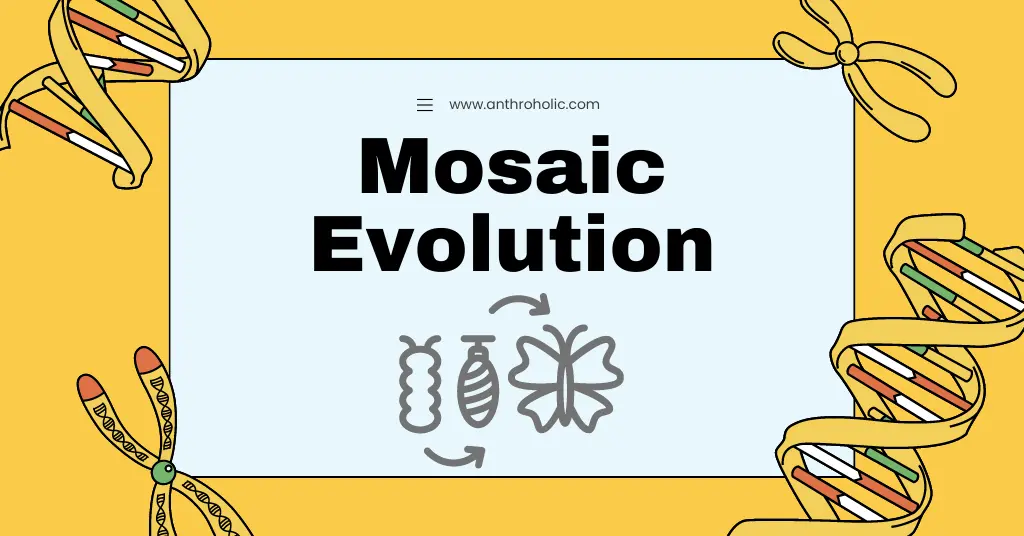AI Answer Evaluation Platform Live Now. Try Free Answer Evaluation Now
Mosaic Evolution
Mosaic evolution refers to the process by which various traits within an organism or lineage evolve at different rates and often independently from one another. This contrasts with the idea that all traits evolve in unison, where all aspects of an organism adapt simultaneously to changing environments or selective pressures.

For example: In Human Evolution , the early evolution of bipedalism in Australopithecus and modification of pelvic girdle took place well before there was any significant change in skull or brain size.
According to the principle of mosaic evolution, the evolution of the species tends to be inconstant and asymmetrical , which means it can be rapid at one time and slow at another. In rare cases it may even virtually stop altogether. At one time evolution may affect the limbs, and at another it may affect the jaws. With a change in the food supply or some other alteration in the environment, running or biting ability, for example, would become more important or less important in natural selection.
This variability in tempo of evolution of different anatomical structures in the same line makes it unwise to draw sweeping conclusions concerning the relationship of two fossil forms on the basis of single characteristics. Instead, it is necessary to follow the evolution of the whole functional system. Since the systems sometimes themselves evolve at different rates, one must also take into account the total morphological pattern of the animal insofar as it is preserved.
Causes for different rates of evolution
The varying rates of evolution among traits can be attributed to several factors:
- Different selective pressures on individual traits
- Genetic drift, which can lead to random changes in traits over time
- Genetic correlations, which can cause the evolution of one trait to influence the evolution of another
Examples of Mosaic Evolution in the Animal Kingdom
A. Hominid evolution
Mosaic evolution is well-documented in the hominid lineage, which includes humans and our closest ancestors. Some examples of mosaic evolution in hominids include:
- Bipedalism: Early hominids evolved to walk on two legs instead of four, a change that occurred at different rates among various species within the lineage.
- Cranial capacity: Over time, hominids developed larger brains, but the rate of brain size increase varied between species.
- Facial features: Hominids experienced changes in facial structure, such as reduced prognathism (protrusion of the face), at different rates across the lineage.
B. Avian evolution
Birds also demonstrate mosaic evolution in several traits:
- Feathers: While feathers initially evolved for insulation, they later developed into specialized structures for flight, display, and camouflage. The evolution of these diverse feather types occurred at different rates among bird species.
- Beaks: Birds exhibit a wide range of beak shapes and sizes, each adapted to specific feeding strategies. The evolution of these beaks progressed at different rates among species, resulting in the diverse array of beak forms we see today.
Examples of Mosaic Evolution in the Plant Kingdom
A. Flower development
Mosaic evolution can be observed in the development of flowers in angiosperms (flowering plants). Key aspects of flower evolution include:
- Petal color: The evolution of petal color in different plant species has occurred at varying rates, driven by factors such as pollinator preferences and ecological context.
- Flower symmetry: Angiosperms display a range of flower symmetries, from radial to bilateral. The evolution of these symmetries has progressed at different rates across species.
- Reproductive structures: The evolution of reproductive structures, such as stamens and pistils, has varied among plant species, driven by factors like pollination strategies and competition for resources.
B. Adaptations in plant lineages
Some plant lineages have undergone mosaic evolution to adapt to their environments:
- Carnivorous plants: In response to nutrient-poor environments, some plants evolved to capture and digest insects. This adaptation occurred at different rates among carnivorous plant species, resulting in a diverse array of trapping mechanisms.
- Succulents: Adaptations to arid environments, such as water-storing tissues and reduced leaves, have evolved at varying rates among succulent species. This has led to a wide range of forms and strategies for water conservation.
Implications of Mosaic Evolution
- Understanding the complexity of evolution: Mosaic evolution challenges the idea of a linear, uniform progression of traits over time. By acknowledging that traits can evolve independently and at different rates, we gain a more nuanced understanding of the complexity of evolutionary processes.
- Importance for conservation and biodiversity: Recognizing mosaic evolution is crucial for conservation efforts. By understanding the unique evolutionary paths of individual traits, we can better appreciate the role these traits play in an organism’s overall adaptation and survival. This knowledge helps inform targeted conservation strategies to protect biodiversity and maintain the delicate balance of ecosystems.
Importance of Mosaic Evolution
- Mosaic evolution plays a key role in macroevolution.
- Mosaic evolution brings stage by stage changes in different parts of organs.
- It sets a flexible framework within which different organs have to grow and develop in relation to other parts of an organism.
- Mosaic Evolution can provide the maximum limit up to which a part of an organism can develop in time with the development of other parts of the body.
- Mosaic evolution shows not only differential evolution but overall adaptive pattern of evolution of an organism.
Conclusion
In conclusion, mosaic evolution offers a fascinating glimpse into the diverse and complex ways that life on Earth has adapted over time. By examining examples from both the animal and plant kingdoms, we can better understand the independent and varying rates of trait evolution and appreciate the intricacies of the natural world. This understanding not only deepens our knowledge of evolutionary biology but also highlights the importance of conserving the rich biodiversity of our planet.




